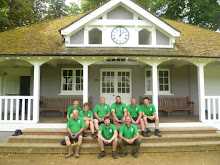 |
| Campsis, Roses And Wisteria On The Top Terrace |
Apart from the daily maintenance tasks, and the larger tasks of applying a leaf mould mulch to some of borders and the removal of a number of years growth of ivy from the Head of Gardens and Grounds office roof, the main focus in January has been the pruning of the many climbing plants and fruit trees in the gardens.
 |
| Climbing Roses On The Front Of The Cottages |
The college gardens are graced with many climbing plants, some very old and some recently planted, as well as an orchard full of fruit trees. The reasons for pruning all of these climbers and trees is to encourage the production of flowers, for fruit trees the more flowers means more fruit, along with removing the dead, damaged and diseased, the three D's, and rejuvenating and renovating the oldest of these plants to keep them healthy and part of the gardens display for many more years to come.
 |
| Wisteria Over The Lower Archway |
The flowering spurs of the wisteria are pruned back to 2-3 buds, unwanted growth removed and any remaining young growth from last year, that was shortened during the summer prune, shortened to create new flowering spurs.
Last years growth on the campsis is also pruned back to 2-3 pairs of buds and the fruiting stems of the kiwi are reduced to 3-4 buds above the previous years fruit producing buds.
The Rosa banksiae has a much simpler prune, just the removal of the untidy, long stems as this early flowering rose, May, had its main prune after it flowered.
The later flowering roses have their main prune at this time of year, the lateral growth and flowering shoots reduced by two thirds/three quarters to a dormant bud.
The fruit trees are pruned with fruit production in mind creating a mixture of 1, 2 and 3 year old wood, fruit buds develop on 2 year old wood, and the old, tired and congested fruiting spurs are removed.
The majority of the pruning has now been completed with just a few climbing roses and fruit trees remaining.
 |
| Rosa banksiae 'Lutea' At The Rear Of The Cottages |
 |
| Kiwi At The Rear Of the Kitchen |
 |
| Climbing Rose At The Rear Of the Kitchen |
 |
| Wisteria, Climbing Rose, Kiwi and Campsis At The Far End Of The Quad |
 |
| Wisteria Over The Top Archway |
 |
| Provost's Wisteria |
 |
| Climbing Roses And Wisteria At The Rear Of The Cottages |
 |
| The Lower Orchard |

















